9,682 people reached
8 Comments 7 Shares
Keya Roy, Nilanjana Mitra, Payal Maru, Nehal Pandey and 132 others
The Fascinating Story Behind Ganesh Chathurthi’s Modern Day Makeover
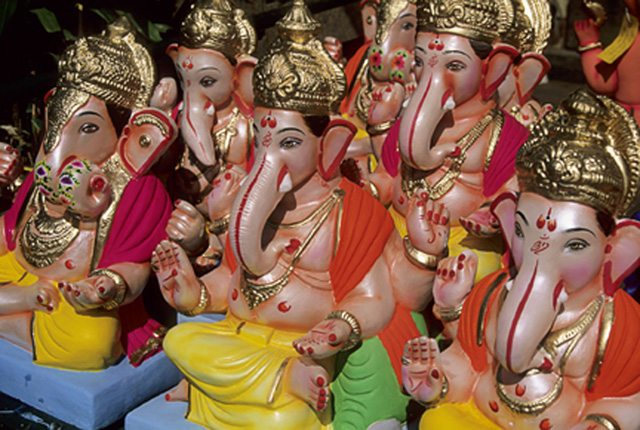
A Birthday Celebration for Lord Ganesha in New York
[dropcap]T[/dropcap]his isn’t Kashi or Prayag but thousands of devotees clog the streets, dancing and chanting as Ganesha’s Ratha Yatra takes place – in Queens, New York. Yes, this pilgrimage spot happens to be in Flushing, Queens, and Hindu-Americans came to celebrate Ganesha Chaturthi from as far as California, Florida, Texas, Atlanta – and even India!
Ganesha Chaturthi is the 9 day Hindu festival celebrating the birth of this joyful deity and is one of the most colorful national festivals of India. In India, after rituals, chanting and prayers, thousands of clay images of Ganesha are taken out in joyous processions in the streets before being immersed in the ocean in a rite called Visarjna. The festival is especially big in Maharashtra, but is now being celebrated in many parts of the Indian Diaspora.
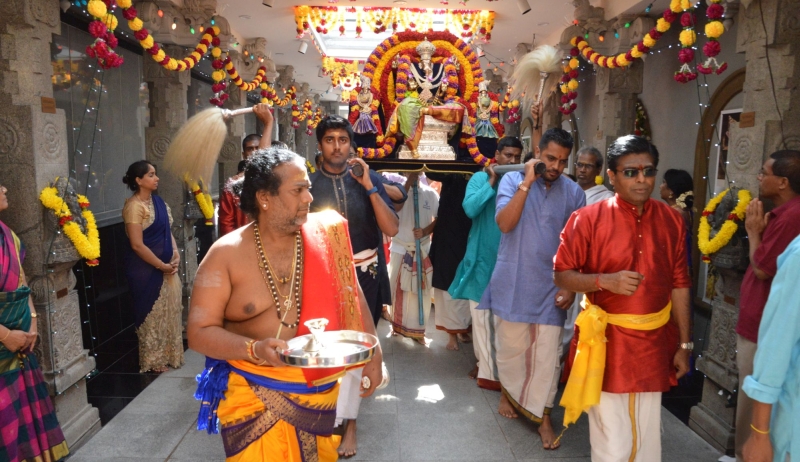
[dropcap]A[/dropcap]ppropriately, the very first Hindu temple to be built in America was the one dedicated to Ganesha, who is after all, the Lord of New Beginnings. The Sri Maha Vallabha Ganapati Devasthanam, also known as the Hindu Temple Society of North America, in Flushing, New York is a magnificent temple in the South Indian tradition. It is here that Ganesh Chaturthi was first celebrated in America in 1977 and has been a major annual event ever since. Ganesh Chaturthi, also known as Vinaya Chaturthi, is celebrated on the chaturthi or fourth day after the new moon in the Tamil month of Avani (August – September.)
Ganesh, the Lord of Auspicious Beginnings
[dropcap]I[/dropcap]t is Lord Ganesha’s birthday and everyone is invited to this giant block party. Over 50,000 lunches are prepared; there are hundreds of pounds of sweets and hundreds of gallons of rose milk. About 20,000 people turn up over the course of nine days at this temple.
Since Ganesha, also known as Ganapati, is the presiding deity at the temple in Flushing, the festival is observed on a grand scale with many prayers, chanting and rituals. During the nine days, devotees chant the Moola Mantram 400,000 times morning and evening, besides many other ceremonies and rituals. There is a special puja session where hundreds of children participate in a special kids’ Ganesh puja.
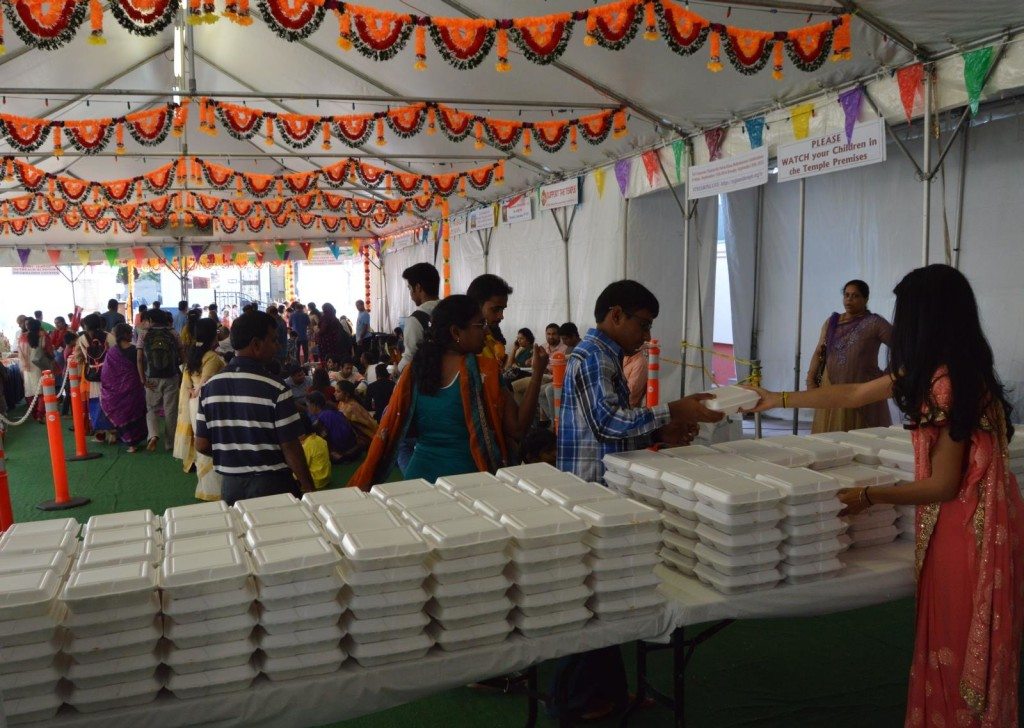
[dropcap]O[/dropcap]n the 9th day, Lord Ganesh is bathed and decorated and readied for the ceremony. The highpoint comes at 1 p.m when He is taken in the rath or chariot out into the streets of Flushing, with devotees pulling the ropes, accompanied by musicians and drummers. The devotees dance, dance and dance in the procession. Along the route merchants in the area ply the masses with food, water and drinks, as thousands of worshipers throng around. Many non-Hindus stop out of curiosity – it’s like a big community fair open to all. Lots of Caucasians also participate in the temple, even in the japa.
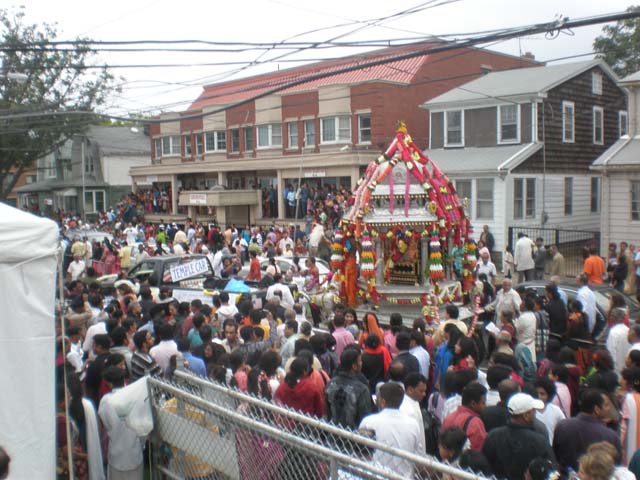
A Farewell to Ganesha
[dropcap]I[/dropcap]n the evening as the sun sets in Hindu communities around the world, thousands of clay images of Ganesha are taken in procession with chanting, music and dancing to be immersed in the ocean in countries across the diaspora. Says Dr. Uma Mysorekar, president of the Hindu Temple Society of North America, “When the clay dissolves in the water, the energy of Ganesha is spread all over, floating across the oceans to bless the entire universe.”
Here, due to environmental concerns, the temple’s clay Ganesha cannot be submerged in a river but is immersed in a plastic swimming pool in the temple’s backyard, as devotees circle around, chant and dance. Once the clay melts into the water over a period of several days, this holy water is sprinkled on the lawn.
“The most important thing is that by being spiritual, by being a devotee, by being a part of this festival it’s also brought the community together,” says Mysorekar. “The number of people who come for the procession is just mind boggling. They come from far, they come from near, regardless of the weather. They love to be a part of the festivities. It only shows the Lord has the supreme power to bring people together.”
She adds, “A temple in this country is not just for worship but it’s also for bringing the community together. In India it’s easy because there are so many places they can go and therefore the temple is mainly for prayers. Here we have got to look at it in a different fashion.”
Indeed, to the jubilant young people dancing in the streets, many barefoot, it’s a chance to express their joy, to be part of something bigger than themselves, absorbing Ganesha’s energy by osmosis. By partaking in the festivities, they celebrate their faith and their community, far from the homeland.
Finding Ourselves in Ganesha – What his Attributes Signify
[dropcap]T[/dropcap]here are several stories in the purãnãs explaining how Ganesha got this unique form. However, a closer look could help us become aware that the form of Lord Ganeša has a deeper meaning, and that it is a symbolic representation of a perfect human being.
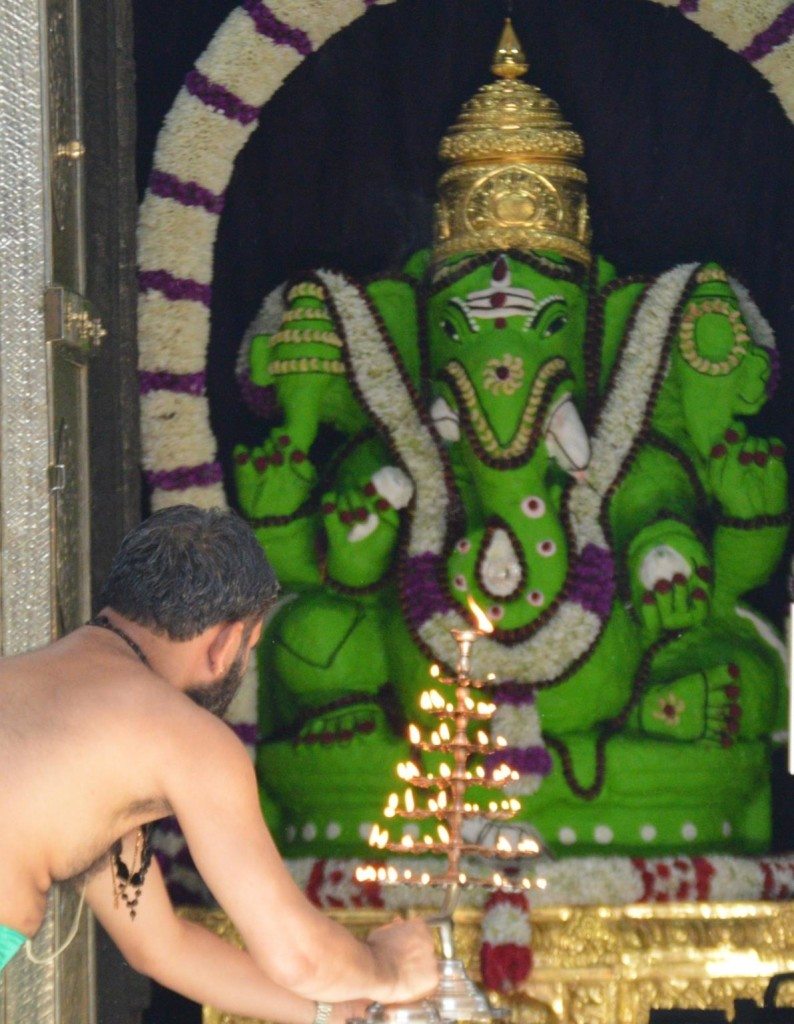
Gajãnanã/Gajamukha, the (large) elephant faced, reminds us to think big and to develop a discriminating intellect.
His eyes are narrowed in deep concentration.
His šoorpa karna (fan-like ears) urge us to listen more, while His hidden mouth alerts us to talk less and curtail our food cravings.
His versatile vakra tunda (curved mouth/trunk) that can uproot a tree and also lift a leaf off the ground, reminds us to recognize when to tackle a problem head on and when to be sensitive and gentle.
He is Eka danta (the single-tusked). By foregoing one of His tusks to help write the epic Mahãbhãrata, He points out the importance of making personal sacrifices for an enduring greater cause.
His mahãkãya/lambodara (huge belly) happily digests all pleasant and unpleasant experiences alike, suggesting that we too follow suit.
Lord Ganeša carries an ankušam (a small axe) in his upper right hand to symbolically help sever His devotees from their binding worldly temptations and attachments.
The pãša (a looped rope) He holds in his upper left hand is a symbolic lasso to pull His devotees towards Him and set them on the path of Truth.
The varada mudra, the boon-giving hand gesture, is an assurance of His infinite benevolent grace, and the modaka (filled with a sweet center) represents Him offering His devotees the supreme knowledge of Brahman leading to Moksha or salvation.
Mooshika Vãhanã, the divine mouse vehicle represents our restless mind filled with fleeting desires and ego that could take us for a ride and lead us astray. Lord Ganeša riding on the Mooshika sets an example for us to take control of our mind.
( Source: Ganeshanjali )
Check out this Photo Gallery
Related Articles
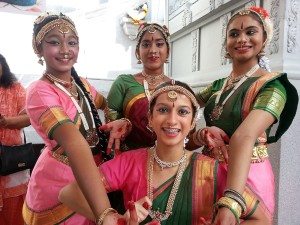
Ganesh Chaturthi: Dressing for the Gods
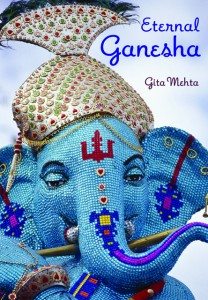
Due to a non-functioning plugin, the FB Likes disappeared 🙁 – if you like the post you can re-start the Likes all over again! Have a brand-new Like button installed!

5 Comments
Thank you and Happy Ganesh Chaturthi to you too! The first Ganesh article I wrote was when I started Lassi with Lavina, since he’s the God of Auspicious Beginnings!
https://www.lassiwithlavina.com/features/faith/meet-ganesha-the-lord-of-new-beginnings/html
Wishing you a Very Happy Prosperous Ganesh Chaturthi, thank you for a beautifully written article
Jai Ganapati! Very Beautiful. Thanks very much for bringing this to those of us who were not able to be there in person. Aum Shanti
True, Congratulations to the author.
Read the Ganesh Chaturthi 2011 article. It appeared to be accurate and display of the divine is as it should be reported. Congratulations to its author and community which supports it.